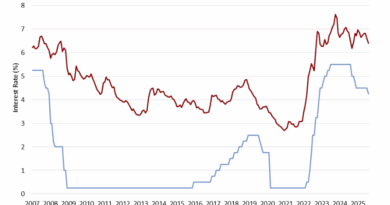Inflation Slows in September
According to the NAHB, inflation continued to ease in September and remained at a 3-year low as shelter costs continued to moderate. Shelter costs, the main driver of inflation since early 2023, saw their annual growth rate fall below 5% for the first time since February 2022. With the Fed beginning its easing cycle with a half-point cut last month, lower interest rates could help ease some pressure on the housing market.
Though shelter remains the primary driver of inflation, the Fed has limited ability to address rising housing costs, as these increases are driven by a lack of affordable supply and increasing development costs. Additional housing supply is the primary solution to tame housing inflation. However, the Fed’s tools for promoting housing supply are constrained.
In fact, tight monetary policy hurts housing supply because it increases the cost of AD&C financing. This can be seen on the graph below, as shelter costs continue to rise at an elevated pace despite Fed policy tightening. Nonetheless, with the Fed shifting to a more dovish stance, along with additional apartment supply supported by real-time private data, NAHB expects to see shelter costs to continue decline in the coming months.
The Bureau of Labor Statistics reported that the Consumer Price Index (CPI) rose by 0.2% in September on a seasonally adjusted basis, the same increase as in July and August. Excluding the volatile food and energy components, the “core” CPI increased by 0.3% in September, the same increase as in August.
The price index for a broad set of energy sources fell by 1.9% in September, with declines in gasoline (-4.1%) and fuel oil (-6.0%) offset by increases in electricity (+0.7%) and natural gas (+0.7%). Meanwhile, the food index rose 0.4%, after a 0.1% increase in August. The index for food away from home increased by 0.3% and the index for food at home rose by 0.4%.
The index for shelter (+0.2%) and food (+0.4%) were the largest contributors to the monthly increase in all items index, accounting for over 75% of the total increase. Other top contributors that rose in September include indexes for motor vehicle insurance (+1.2%), medical care (+0.4%), apparel (+1.1%) and airline fares (+3.2%). Meanwhile, the top contributors that experienced a decline include indexes for recreation (-0.4%) and communication (-0.6%).
The index for shelter makes up more than 40% of the “core” CPI. The index saw a 0.2% rise in September, following an increase of 0.5% in August. Both the indexes for owners’ equivalent rent (OER) and rent of primary residence (RPR) increased by 0.3% over the month. These gains have been the largest contributors to headline inflation in recent months.




